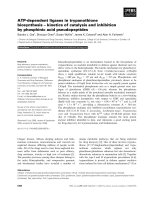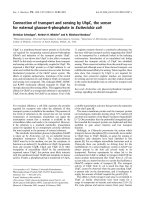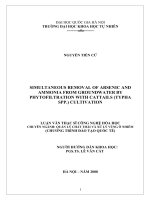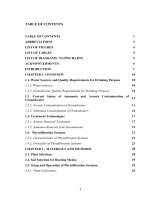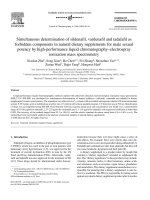simultaneous determination of PAHs and PCBs by GCMS Analysis
Bạn đang xem bản rút gọn của tài liệu. Xem và tải ngay bản đầy đủ của tài liệu tại đây (144.78 KB, 17 trang )
Simultaneous Determination of
PAHs and PCBs by GCMS
Analysis.
BGS Laboratory Technique Development (E2156S67)
Internal Report IR/07/045
BRITISH GEOLOGICAL SURVEY
BGS LABORATORY TECHNIQUE DEVELOPMENT (E2156S67)
INTERNAL REPORT IR/07/045
Simultaneous Determination of
PAHs and PCBs by GCMS
Analysis.
Alex Kim and Chris Vane
The National Grid and other
Ordnance Survey data are used
with the permission of the
Controller of Her Majesty’s
Stationery Office.
Licence No: 100017897/2005.
Keywords
Polycyclic aromatic
hydrocarbons, poly chlorinated
biphenyles, gas chromatography
mass spectrometry
Bibliographical reference
A
LEX KIM & CHRIS VANE. 2007.
Simultaneous Determination of
PAHs and PCBs by GCMS
Analysis. British Geological
Survey Internal Report,
IR/07/045. 9pp.
Copyright in materials derived
from the British Geological
Survey’s work is owned by the
Natural Environment Research
Council (NERC) and/or the
authority that commissioned the
work. You may not copy or adapt
this publication without first
obtaining permission. Contact the
BGS Intellectual Property Rights
Section, British Geological
Survey, Keyworth,
e-mail You may
quote extracts of a reasonable
length without prior permission,
provided a full acknowledgement
is given of the source of the
extract.
Maps and diagrams in this book
use topography based on
Ordnance Survey mapping.
© NERC 2007. All rights reserved
Keyworth, Nottingham British Geological Survey 2007
The full range of Survey publications is available from the BGS
Sales Desks at Nottingham, Edinburgh and London; see contact
details below or shop online at www.geologyshop.com
The London Information Office also maintains a reference
collection of BGS publications including maps for consultation.
The Survey publishes an annual catalogue of its maps and other
publications; this catalogue is available from any of the BGS Sales
Desks.
The British Geological Survey carries out the geological survey of
Great Britain and Northern Ireland (the latter as an agency
service for the government of Northern Ireland), and of the
surrounding continental shelf, as well as its basic research
projects. It also undertakes programmes of British technical aid in
geology in developing countries as arranged by the Department
for International Development and other agencies.
The British Geological Survey is a component body of the Natural
Environment Research Council.
British Geological Survey offices
Keyworth, Nottingham NG12 5GG
0115-936 3241 Fax 0115-936 3488
e-mail:
www.bgs.ac.uk
Shop online at: www.geologyshop.com
Murchison House, West Mains Road, Edinburgh EH9 3LA
0131-667 1000 Fax 0131-668 2683
e-mail:
London Information Office at the Natural History Museum
(Earth Galleries), Exhibition Road, South Kensington, London
SW7 2DE
020-7589 4090 Fax 020-7584 8270
020-7942 5344/45 email:
Forde House, Park Five Business Centre, Harrier Way,
Sowton, Exeter, Devon EX2 7HU
01392-445271 Fax 01392-445371
Geological Survey of Northern Ireland, Colby House,
Stranmillis Court, Belfast BT9 5BF
028-9038 8462 Fax 028-9038 8461
Maclean Building, Crowmarsh Gifford, Wallingford,
Oxfordshire OX10 8BB
01491-838800 Fax 01491-692345
Columbus House, Greenmeadow Springs, Tongwynlais,
Cardiff, CF15 7NE
029–2052 1962 Fax 029–2052 1963
Parent Body
Natural Environment Research Council, Polaris House,
North Star Avenue, Swindon, Wiltshire SN2 1EU
01793-411500 Fax 01793-411501
www.nerc.ac.uk
BRITISH GEOLOGICAL SURVEY
i
Foreword
This report is the published product of a study by the British Geological Survey (BGS) into the
development of a technique for the simultaneous determination of PAHs and PCBs by GCMS
analysis.
A multiple component mixture of PAH and PCB analytes together with their respective internal
standards were used to establish GC method for their separation. It was also used to develop the
supporting software to automatically identify the compounds.
Acknowledgements
The authors would like to thank Mr Shaun Reeder for supporting the concept of the work and for
making available the corresponding time and funding under the BGS Laboratory Technique
Development Programme (MaDCap Project).
ii
Contents
Foreword i
Acknowledgements i
Contents ii
Summary iii
1. Introduction 1
1.1 General 1
1.2 Polycyclic Aromatic Hydrocarbons (PAHs) 1
1.3 Polychlorinated Biphenyls (PCBs) 2
1.4 The Need for this study 2
2. Method Development 3
2.1 Materials and reagents 3
2.2 Chromatography 3
3. Results and Discussion 4
3.1 Chromatography and Software 4
4. Conclusions 5
References 6
FIGURES
Figure 1 Total Ion Chromatogram (TIC) showing simultaneous analysis of PAH and PCB
standards 7
TABLES
Table 1 PAHs used and respective analytical ions used for quantification 8
Table 2 PCBs used and respective analytical ions used for quantification 9
iii
Summary
A method for the simultaneous separation and identification of PAHs and PCBs by GCMS was
successfully developed by this laboratory.
The programming of associated software to identify and differentiate between similar
compounds was an integral part of this development.
1
1. Introduction
1.1 GENERAL
Public concern over contamination of the built environment has grown rapidly as the potential
health hazards of past and present industrialisation have become recognised. Under the
Environmental Protection Act 1990 and the Environment Act 1995, there is a requirement for
each local authority to inspect its own area for contaminated land and monitor air quality.
Structural planning strategies within built areas are required to optimise the use of land resources
for new development. Since the Industrial Revolution vast quantities of hydrocarbons have been,
and still are, contaminating the environment. Past and present use of land on which fossil fuels
are utilised include: power generation, transport, oil refineries, gasworks, mining, chemical
industries, landfill sites and scrap yards. Over time these activities have resulted in varying levels
of topsoil contamination by direct spillage and fall out. With the expansion of conurbations and
changes of land use these sites are now often located within residential areas. The dereliction of
industrial sites, brownfield-site redevelopment and increased road traffic are all potential sources
of air-borne particle pollution (Department for Environment, Food and Rural Affairs, 2001).
1.2 POLYCYCLIC AROMATIC HYDROCARBONS (PAHs)
The abbreviation PAHs denotes polycyclic aromatic hydrocarbons, which are a class of organic
compounds, characterised by two or more fused aromatic rings. Occurring in the environment,
they give cause for concern because some display toxic, mutagenic and carcinogenic activity
(Menzie et al., 1992). In general, low molecular weight two- and three-ringed PAHs have a
significant acute toxicity, whereas four- to six-ringed PAHs tend to display a greater
carcinogenicity (Witt, 1995).
The presence of PAHs in the environment is the result of a variety of anthropogenic and biogenic
activities with incomplete combustion and pyrolysis of fossil fuels serving as the major source
(McCready et al., 2000). This pyrolitic input may be supplemented by PAHs originating from
grass and forest fires. In specific locations there may also be a petrogenic contribution of PAHs
from crude oil, coal and various refinery products. Frequently, anthropogenic in origin and
commonly arising from run-off, industrial and sewage discharges, spillage, shipping activities
etc. this source can in some cases though be natural as, for instance, oil seepage from depth.
Additionally, but to a lesser extent, petrogenic PAHs in sediments can originate from the
diagenesis of natural precursors like terpenes, pigments and steroids.
Many hundreds of PAHs exist in the environment, but the US Environmental Protection Agency
(USEPA) has listed sixteen as “Consent Decree” priority pollutants chosen because:
• most information is available on these PAHs
• they are suspected of being more harmful than most other PAHs
• they exhibit harmful effects representative of PAHs
• chance of exposure to these is greater than to other PAHs
• these PAHs had the highest concentrations at hazardous waste sites.
2
Normally, it is the USEPA 16 PAHs that are selected in the majority of publications that focus
upon environmental PAH pollution. However, information arising from knowledge of these
does not usually provide sufficient detail on PAH distributions to permit definitive links to be
made to specific sources of contamination. Their principle value is in providing an estimate of
total and individual PAH concentrations.
1.3 POLYCHLORINATED BIPHENYLS (PCBs)
The class of organic compounds known as Polychlorinated Biphenyls (PCBs) are known to
cause cancer and affect immune, reproductive, nervous and as well as endocrine systems in
animals. Studies on humans confirm their potential carcinogenic and non-carcinogenic effects.
Mixtures of PCBs tend to be chemically stable, non-flammable and electrically insulating with
high boiling points. These properties made PCBs ideal for use in the electricity and mining
industries as cooling, insulating and hydraulic fluids. With the exception of production and
disposal sites the main sources of PCB emissions include power transformers, capacitors,
hydraulic oils, thermal and lubricating oils. Alternative sources include release from paints,
printing inks, sealants and adhesives as well as rubber plasticizers. An estimated 40,000 t of total
PCBs were commercially manufactured in the UK from 1954 onwards, peak production was
achieved in mid-1960’s before declining throughout the 1970’s due to restrictions and an
eventual UK sales ban in 1977. The most common formulations were Aroclors which are
comprised of congeners 28, 52, 101, 138, 153 and 180. The commercial and industrial
manufacture of these toxic compounds, were, subject to eventual ban in 1985 under the OSPAR
convention (OSPAR 1997).
PCBs are persistent in the environment and accumulate in soils, marine sediments, seawater,
sewage sludge and vegetation as well as the fatty tissues of animals. The river systems receive
polluted waste from shipbuilding, textile, paper and engineering industries (Edgar et al., 1999;
Edgar et al., 2003). Additional sources of anthropogenic contaminants such as PCBs include
effluent and accidental discharges from military bases and from sewage sludge disposal (Kelly
1995). The combination of high population density and heavy industry has consequently created
the issue of PCB pollution. After entering the environment PCBs accumulate in sediments and/or
biological tissues as compared to water because of physiochemical factors such as low vapour
pressures and low solubility.
1.4 THE NEED FOR THIS STUDY
The scope of this method, and hence its validation, is the determination of 16 individual USEPA
PAHs and 8 individual PCBs in sediments. Currently these analyses require 2 separate
determinations. It is proposed to combine the 2 methods to enable us to offer one unit analysis to
determine both PAH and PCB concentrations simultaneously. The ability to do this will be
dependent on the relative concentrations PCBs to PAHs in any one sample because PCBs are
usually in much lower concentrations compared to PAHs (i.e. PAHs may require dilution so as
not to over load the GCMS and thus dilute the PCBs below their limit of quantification).
3
2. Methods
2.1 MATERIALS AND REAGENTS
All standards and stock solutions were stored in a 5mL vial fitted with a Mininert
TM
valve at 4°C
in darkness.
PAH Standards. All internal standard PAH compounds were purchased from Sigma Aldrich
Chemical Co. (Gillingham, Dorset, UK). PAH analytes were purchased as a mixture from LGC
PromoChem (Teddington, Middlesex, U.K.), these are listed in Table 1.
PCB Standards. All PCB internal standards, sample evaluation / preparation standards
(SES/SPS), recovery determination standard (RDS) and retention time window PCBs were
purchased as individual compounds from LGC PromoChem (Teddington, Middlesex, U.K.).
PCB analytes were purchased as a mixture (7 PCB Mix CERTAN, 10µg/mL in iso-octane) from
the same supplier, these are listed in Table 2.
2.2 GCMS ANALYSIS
The GCMS used was a Varian 1200L GC-MS-MS. Mass range: full scan ion monitoring (m/z:
40-600), scan time was 0.5 second, with electron impact and quadrupole analyser. Split/splitless
injection (1:25 at 250°C) was onto a DB-1 column (60m length x 0.32 mm i.d. x 0.25 µm film
thickness). Oven temperature programme: 60°C (1 min. isothermal) to 200°C (at 5°C / min.) to
280°C (at 2.6°C / min.) to 320°C (at 20°C / min.) and isothermal at 320°C for 10 minutes.
Carrier gas: helium at 1mL/min.
4
3. Results and Discussion
3.1 CHROMATOGRAPHY AND SOFTWARE
A 40 component mixture was made (Table 1 and Table 2) excluding retention time window
PCBs. The mixture was analysed in the full-scan mode (Figure 1). The retention times and the
mass spectra of the compounds were identified using the NIST-MS library search.
The instrument software ‘Varian MS Workstation – MS Data Review, version 6.5’ was used to
automatically identify these compounds which involved programming in an extensive list of
specific qualifying ion ratios and retention time windows (Table 1 and Table 2).
The chromatogram presented in Figure 1 shows the elution of all compounds and their
separation. The ratio PAH : PCB concentrations in this standard was 10:1 which represents the
higher proportion of PAHs relative to PCB which is encountered in many environmental
matrices (e.g. soils and sediments).
When viewed as a single ion chromatogram, excellent resolution of closely eluting compounds is
clearly seen as between Py-d10:Py and B[a]A:Ch-d10. The isomers B[b]F and B[k]F are 80%
resolved by 2 seconds. Some slight peak tailing is noticeable after 55 minutes retention time.
Peak width increases with retention time (RT), this is observed where the naphthalene peak
width is 10 seconds (RT = 15.85 minutes) and increases to 20 seconds for B[ghi]Per (RT = 64.00
minutes). Column bleed becomes noticeable after 60minutes (>280°C), this does not affect the
peak-height : background ratio of the analytes in this region when the quantitative ions are
viewed as a single ion chromatogram (i.e. Ind[1,2,3,-cd]Py and B[ghi]Per at m/z 276 give well
defined peak shapes). In Figure 1 it is noted that there seems to be chromatographic
discrimination of the high boiling point compounds after 40 minutes retention time. This can be
improved by using a splitless injection technique combined with a higher injector temperature.
GCMS vs. HPLC: The higher chromatographic resolution of GCMS is possible to separate
alkylated PAHs such as the alkylated phenanthrenes, this is particularly important for petrogenic
/ pyrogentic source determination. Secondly, HPLC can only detect 15 of the 16 USEPA PAHs,
because the fluorescence detector is unable to detect acenaphthylene, which has a negligible
fluorescence.
Simultaneous chromatography of PAH and PCB pollutants is achievable using current
instrumentation with in the BGS labs. It is envisaged that once proven to work on certified
reference materials and selected reference materials the novel method outlined in this study will
be offered as an analytical service to external and internal customers.
5
4. Conclusions
A method for the simultaneous separation and identification of PAHs and PCBs by GCMS was
successfully developed by this laboratory.
The programming of associated software to identify and differentiate between similar
compounds was an integral part of this development.
Further work could include application of the method to determine limits of quantification,
response factors and subsequent determination of PAHs and PCBs in certified reference
materials (CRMs). When proven to work with CRMs this method will be offered as an analytical
service to external and internal customers.
6
References
Most of the references listed below are held in the Library of the British Geological Survey at
Keyworth, Nottingham. Copies of the references may be purchased from the Library subject to
the current copyright legislation.
DEPARTMENT FOR ENVIRONMENT, FOOD AND RURAL AFFAIRS. 2001. The Air Quality Strategy for England, Scotland, and Wales
and Northern Ireland; A consultation document on proposals for air quality objectives for particles, benzene, carbon monoxide
and poly aromatic hydrocarbons. September 2001.
E
DGAR, P.J., HURSTHOUSE, A.S., MATTHEWS, J.E. AND DAVIES, I.M. 2003. An investigation of geochemical factors controlling
the distribution of PCBs in intertidal sediments at a contamination hotspot, the Clyde Estuary, UK. Applied Geochemistry, Vol.
18, 327–338.
E
DGAR, P.J., DAVIES, I.M., HURSTHOUSE, A.S. AND MATTHEWS, J.E. 1999. The biogeochemistry of polychlorinated biphenyls
(PCBs) in the Clyde: Distribution and evaluation. Marine Pollution Bulletin, Vol. 38(6), 486–496.
K
ELLY, A. G 1995. Accumulation and persistence of chlorobiphenyls, oprganochlorine pesticides and faecal sterols at the
Garroch Head sewage sludge disposal site, Firth of Clyde. Environmental Pollution, Vol. 88, 207–217.
MCCREADY, S, SLEE, D J, BIRCH, G F and TAYLOR, S E. 2000. The distribution of polycyclic aromatic hydrocarbons in surficial
sediments of Sydney Harbour, Australia. Marine Pollution Bulletin, Vol. 40, 999–1006.
M
ENZIE, C A, POTOCKI, B B and SANTODONATO, J. 1992. Exposure to carcinogenic PAHs in the environment. Environmental
Science and Technology, Vol. 26, 1278–1284.
OSPAR. 1997. Oslo And Paris Conventions For The Prevention Of Marine Pollution Joint Meeting Of The Oslo And Paris
Commissions, Brussels: 2-5 September 1997, Agreed Background / Reference Concentrations for Contaminants in Sea Water,
Biota and Sediment.
W
ITT, G. 1995. Polycyclic aromatic hydrocarbons in water and sediment of the Baltic Sea. Marine Pollution Bulletin, Vol. 31,
237-248.
7
Table 1. PAHs used and respective analytical ions used for quantification; RT = retention time; FW = formula weight
Name Abbreviation
RT
(min.)
Rings Type FW Formula CAS 1° ion
Analytical
ion
Qualifying ions
Conc
n
(ng/µL)
Notes
naphthalene Nap 15.886 2 analyte 128.17 C10H8 91-20-3 128.0 128.3 127.5,102.0,129.1
1-methylnaphthalene-d10 MN-d10 19.255 2 internal std. 152 C10D7(CD3) 38072-94-5 152.0 152.0 152.1,122.0,151.1 0.593
acenaphthylene Ay 22.875 2.5 analyte 152 C12H8 208-96-8 152.4 152.4 151.4,150.0,76.0 0.500
acenaphthene Ae 23.766 2.5 analyte 154 C12H10 83-32-9 153.0 153.0 154.1,152.0,76.0 0.500
fluorene Fluo 26.143 2.5 analyte 166 C13H10 86-73-7 166.0 166.0 163.0,164.0,82.2 0.500
phenanthrene-d10 Ph-d10 30.405 3 internal std. 188 C14D10 1517-22-2 188.4 188.4 184.1,189.2,158.1 0.623
phenanthrene Ph 30.500 3 analyte 178 C14H10 85-01-8 178.3 178.3 176.0,179.0,151.0 0.500
anthracene Anth 30.750 3 analyte 178 C14H10 120-12-7 178.3 178.3 176.0,179.0,151.0 0.500
3,6-dimethylphenanthrene 3,6-DMP 36.044 3 RDS 206 C14H8(CH3)2 1576-67-6 206.3 206.3 191.0,205.3,102.0 0.580
fluoranthene F'anth 37.201 4 analyte 202 C16H10 206-44-0 202.4 202.4 201.4,200.0,101.0 0.500
pyrene-d10 P-d10 38.384 4 internal std. 212 C16D10 1718-52-1 212.3 212.3 211.3,106.0,208.1 0.608
pyrene Py 38.481 4 analyte 202 C16H10 129-00-0 202.4 202.4 201.4,200.0,101.0 0.500
4-terphenyl 4-TP 40.391 3 internal std. 230 C6H5C6H4C6H5 92-94-4 230.0 230.0 231.2,115.0,228.0 0.632
benzo[a]anthracene B[a]A 47.268 4 analyte 228 C18H12 56-55-3 228.0 228.0 226.0,229.1,113.9 0.500 co-elutes with Ch-d12
chrysene-d12 Ch-d12 47.304 4 internal std. 240 C18D12 1719-03-5 240.1 240.1 236.1,241.2,120.0 0.577 co-elutes with B[a]A
chrysene Ch 47.483 4 analyte 228 C18H12 218-01-9 228.0 228.0 226.0,229.1,113.9 0.500
benzo[b]fluoranthene B[b]F 55.447 5 analyte 252 C20H12 205-99-2 252.0 252.0 250.0,126.0,113.0 0.500 also called: benz[e]acephenanthrylene
benzo[k]fluoranthene B[k]F 55.619 5 analyte 252 C20H12 207-08-9 252.0 252.0 250.0,126.0,113.0 0.500
benzo[a]pyrene B[a]Py 57.516 5 analyte 252 C20H12 50-32-8 252.0 252.0 250.0,126.0,113.0 0.500
3-methylcholanthrene 3-MeChol 60.470 5 internal std. 268 C21H16 56-49-5 268 268 252.0,253.0,126.0 0.604
indeno[1,2,3-cd]pyrene I[1,2,3-cd]Py 63.199 6 analyte 276 C22H12 193-39-5 276 276 274.0,137.4,138.3 0.500 unresolved from DB[ah]A
dibenz[ah]anthracene DB[ah]A 63.340 5 analyte 278 C20H12 53-70-3 278 278 139.0,279.0,276.0 0.500 unresolved from I[1,2,3-cd]Py
benzo[ghi]perylene B[ghi]Per 64.059 7 analyte 276 C22H12 191-24-2 276 276 138.0,137.0,274.0 0.500
8
Table 2. PCBs used and respective analytical ions used for quantification. SES / SPS = sample evaluation / preparation standard; RDS = recovery
determination standard; RT = retention time; FW = formula weight
Name Abbreviation RT (min.)
Cl
atoms
Type FW Formula
CAS
No.
1° ion
Analytical
ion
Qualifying ions
Conc
n
(ng/µL)
Notes
2,2',6-trichlorobiphenyl PCB 019 29.508 3 SES/SPS 257.5 C12H7Cl3 038444-73-4 186 256 257.9,186.0,150.0 0.39
2',3,5-trichlorobiphenyl PCB 034 31.888 3 IS 257.5 C12H7Cl3 037680-98-5 186 256 258,186,150 0.48
2,2',6,6'-tetrachlorobiphenyl PCB 054 31.916 4 first tetra 292.0 C12H6Cl4 015968-05-5 292 co-elutes just after PCB 034
2,4,5-trichlorobiphenyl PCB 029 32.107 3 RDS 257.5 C12H7Cl3 01586-07-4 186 256 258,186,150 0.41
2,4,4'-trichlorobiphenyl PCB 028 32.671 3 analyte 257.5 C12H7Cl3 7012-37-5 186 258 258,256,150 0.50
2,2',5,5'-tetrachlorobiphenyl PCB 052 34.336 4 analyte 292.0 C12H6Cl4 35693-99-3 220 292 290,222,150 0.50
2,3,4,6-tetrachlorobiphenyl PCB 062 35.058 4 IS 292.0 C12H6Cl4 054230-23-7 220 292 222,150 0.47
2,2',4,6,6',-pentachlorobiphenyl PCB 104 35.183 5 first penta 326.5 C12H5Cl5 056558-16-8 326
2,2',4,4',6,6'-hexachlorobiphenyl PCB 155 38.543 6 first hexa 361.0 C12H4Cl6 033979-03-2 360
2,2',4,5,5'-pentachlorobiphenyl PCB 101 38.867 5 analyte 326.5 C12H5Cl5 37680-73-2 325.8 325.8 327.7,184.0,109.0 0.50
2,3',4,4',6-pentachlorobiphenyl PCB 119 39.505 5 IS 326.5 C12H5Cl5 056558-17-9 325.8 326 327.7,184.0,109.0 0.47
3,3',4,4'-tetrachlorobiphenyl PCB 77 40.612 4 last tetra 292.0 C12H6Cl4 032598-13-3 292
2,2',3,4',5,6-hexachlorobiphenyl PCB 147 41.963 6 SES/SPS 361.0 C12H4Cl6 068194-13-8 289.8 359.7 361.7,217.9,144.9 0.50
2,3',4,4',5-pentachlorobiphenyl PCB 118 42.727 5 analyte 326.5 C12H5Cl5 31508-00-6 325.8 325.8 327.7,184.0,109.0 not in PCB-Mix 7
2,2',3,3',4,6,-hexachlorobiphenyl PCB 131 42.981 6 IS 361.0 C12H4Cl6 091798-70-7 289.8 360 361.7,217.9,144.9 0.46
2,2',3,4',5,6,6'-heptachlorobiphenyl PCB 188 43.368 7 first hepta 395.5 C12H3Cl7 074487-85-7 394
2,2',4,4',5,5',-hexachlorobiphenyl PCB 153 43.692 6 analyte 361.0 C12H4Cl6 35065-27-1 359.8 359.8 361.7,217.9,144.9 0.50
2,2',3,4,4',5'-hexachlorobiphenyl PCB 138 45.085 6 analyte 361.0 C12H4Cl6 35065-28-2 359.7 359.7 361.7,217.9,144.9 0.50
3,3',4,4',5-pentachlorobiphenyl PCB 126 45.522 5 last penta 326.5 C12H5Cl5 057465-28-8 326
2,3,3',4,4',5'-hexachlorobiphenyl PCB 157 48.308 6 RDS 361.0 C12H4Cl6 069782-90-7 359.7 359.7 361.7,217.9,144.9 0.39
2,2',3,3',4,5,6-heptachlorobiphenyl PCB 173 48.443 7 IS 395.5 C12H3Cl7 068194-16-1 393.7 393.7 395.7,161.8 0.45
2,2',3,4,4',5,5'-heptachlorobiphenyl PCB 180 49.275 7 analyte 395.5 C12H3Cl7 35065-29-3 393.7 393.7 395.7,161.8 0.50
3,3',4,4',5,5'-hexachlorobiphenyl PCB 169 50.388 6 last hexa 361.0 C12H4Cl6 032774-16-6 360
2,3,3',4,4',5,5'-heptachlorobiphenyl PCB 189 52.680 7 last hepta 395.5 C12H3Cl7 039635-31-9 394
9
Nap
20
PCB
019
PCB
028
PCB
029
PCB
034
MN-d10
Ay
Ae
Fluo
Ph-d10
Ph
Anth
3,6-DMP
F
Py-d10
4-TP
Ch
B[b]F
B[k]F
3-MeChol
Ind[1,2,3,-cd]Py
DB[ah]A
B[ghi]Per
B[a]Py
B[a]A
&
Ch-d12
Py
PCB
052
PCB
062
PCB
101
PCB
147
PCB
131
PCB
131
PCB
157
PCB
173
PCB
180
PCB
138
PCB
119
30 40
50 60 70
Retention Time (minutes)
Figure 1
Total Ion Chromatogram (TIC) showing simultaneous analysis of PAH (10ng) and PCB (1ng) standards. A key to the peak labels is
presented in Table 1 and Table 2

